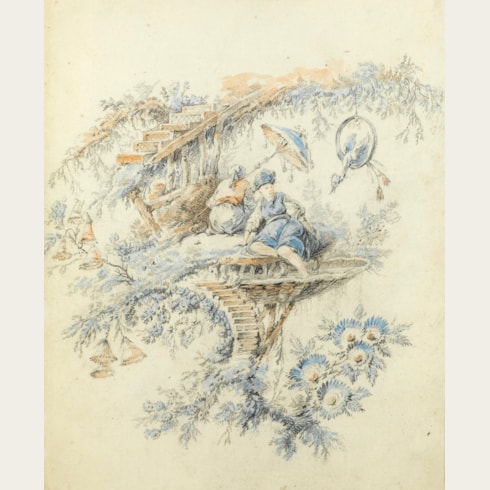Jean-Baptiste PILLEMENT
(Lyon 1728 - Lyon 1808)
A Chinoiserie Design, with a Seated Oriental Musician
Signed and dated Jean: Pillement. 1764 at the lower left centre.
348 x 235 mm. (13 3/4 x 9 1/4 in.)
As Maria Gordon-Smith has noted of the second edition of A New Book of Chinese Ornaments, which appeared in 1757, ‘From this point on, chinoiseries became Pillement’s very own domain. This collection was the first of many to place him as the heir to the chinoiserie tradition of Watteau and Boucher. However, in his interpretations the exotic motifs were even more independent from any imitations of Far Eastern originals and represented a highly personal imaginative faculty. What was probably intended to be, at first, an incidental and minor commercial occupation, turned out to be an immediate revelation and eventually a source of lasting fame for the artist.’ In all, more than three hundred prints after Pillement’s landscape, ornament and chinoiserie drawings appeared while he was working in London.
Pillement continued to produce new and novel designs for chinoiseries throughout his stay in England and afterwards, and in 1767 a collection of his designs was published with the title One hundred and thirty figures and ornaments, and some flowers, in the Chinese style. The success of this project added greatly to Pillement's reputation, and his designs were to prove a significant influence on the decorative arts in Europe for many years.
This delightful sheet, signed in full and dated 1764, is likely to have been produced as a collector’s drawing in its own right. However, a very similar compositional arrangement, with four Oriental musicians – each depicted seated on platforms beneath a canopy hung with bells and surmounted by a blue cloth - appears in Pillement’s painted chinoiserie decoration of a large hall in the palace of Schloss Niederweiden in Austria, commissioned by the Empress Maria Theresa around 1764 and completed by the spring of the following year. As a recent scholar has described the room, ‘Between the windows, surrounded with flower-covered trelliswork, four large chinoiserie figures appear on each side of the room seated on ornate platforms within a frame of draperies adorned with bells and surmounted by canopies surrounded by a profusion of climbing flowers.’
Such charming and original compositions as this, with their immense visual appeal, were the source of much of the artist’s contemporary fame. As another author has written, ‘[Pillement’s] chinoiseries exaggerate wispy, fragile qualities of the style. It is as though the world is a fairyland conjured out of gossamer and stalks of grass, and the humans inhabiting it, fanciful little creatures who dance and tumble around so effervescent and lively they seem more creatures of the air than earth.’
‘An artist with a great deal of merit, gifted with a prodigious talent, this busy man worked in all genres (except history painting and portraiture) in oil, pastel, chalk, ink, pencil, and always with an ease, a facility, a remarkable rapidity. His touch is extremely firm, neat, precise. One never sees hesitation or indecision in his works, all of which are characterized by a great harmony, and by an abundance of spirit.’ Thus was Jean Pillement described some twenty years after his death, and such assessments of his abilities have lasted into the present day, with one modern scholar aptly describing the artist as ‘a versatile painter and an exquisite draughtsman’.
One of the most influential decorative and ornamental draughtsmen working in Europe in the second half of the 18th century, Pillement was an equally gifted painter, producing pastoral landscapes, marines, flowerpieces, animal subjects and chinoiseries. A precocious talent, by the age of fifteen was working as a designer at the Gobelins tapestry factory in Paris. In 1745, aged seventeen, he left France to spend three years in Madrid. This was to be the first in a long series of travels throughout Europe over the next forty years. After a period in Lisbon, where he was offered, and declined, the title of Painter to the King, Pillement spent the next few years working in London, between 1754 and 1763. His pastoral scenes, seascapes and picturesque views found an appreciative audience in England, and he became a popular and re¬spected member of artistic society in London. It was also in England in the 1750’s that some of his ornamental designs were first engraved and published, and where he established himself as a fashionable decorative painter.
Pillement continued to travel extensively during the 1760’s, receiving several prestigious commissions. Between 1763 and 1765 he was in Vienna, where he won commissions from the Empress Maria Theresa and the Prince of Liechtenstein. He was appointed court painter to King Stanislas August Poniatowski of Poland, for whom he decorated rooms in the Royal Castle and the palace of Ujazdów in Warsaw between 1765 and 1767. Back in France and appointed peintre de la reine in 1778, Pillement painted three decorative canvases for Marie Antoinette’s Petit Trianon at Versailles; the only real instance in his long career of an official French commission. For much of the 1780’s he worked in Portugal and Spain, and it was during this period that he produced some of his finest landscape drawings. Returning to France in 1789, he abandoned Paris during the Revolution and spent much of the decade of the 1790’s working in the small town of Pezénas in the province of Languedoc. The last years of Pillement’s career found the artist in his native Lyon, where he was employed at the Manufacture de Soie et des Indiennes and gave lessons in decoration and design. He died in relative obscurity at the age of eighty, his output having suffered from the decline of the French taste for the rococo in the aftermath of the Revolution.
Provenance
Anonymous sale (Succession de Monsieur et Madame X), Paris, Hôtel Drouot, 22 March 2007, lot 130.
Literature















